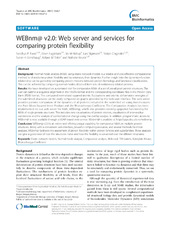| dc.contributor.author | Tiwari, Sandhya Premnath | |
| dc.contributor.author | Fuglebakk, Edvin | |
| dc.contributor.author | Hollup, Siv Midtun | |
| dc.contributor.author | Skjærven, Lars | |
| dc.contributor.author | Cragnolini, Tristan | |
| dc.contributor.author | Grindhaug, Svenn Helge | |
| dc.contributor.author | Tekle, Kidane M | |
| dc.contributor.author | Reuter, Nathalie | |
| dc.date.accessioned | 2016-11-04T13:19:22Z | |
| dc.date.available | 2016-11-04T13:19:22Z | |
| dc.date.issued | 2014-12-30 | |
| dc.Published | BMC Bioinformatics 2014, 15(1):427 | eng |
| dc.identifier.issn | 1471-2105 | en_US |
| dc.identifier.uri | https://hdl.handle.net/1956/13058 | |
| dc.description.abstract | Background: Normal mode analysis (NMA) using elastic network models is a reliable and cost-effective computational method to characterise protein flexibility and by extension, their dynamics. Further insight into the dynamics–function relationship can be gained by comparing protein motions between protein homologs and functional classifications. This can be achieved by comparing normal modes obtained from sets of evolutionary related proteins. Results: We have developed an automated tool for comparative NMA of a set of pre-aligned protein structures. The user can submit a sequence alignment in the FASTA format and the corresponding coordinate files in the Protein Data Bank (PDB) format. The computed normalised squared atomic fluctuations and atomic deformation energies of the submitted structures can be easily compared on graphs provided by the web user interface. The web server provides pairwise comparison of the dynamics of all proteins included in the submitted set using two measures: the Root Mean Squared Inner Product and the Bhattacharyya Coefficient. The Comparative Analysis has been implemented on our web server for NMA, WEBnm@, which also provides recently upgraded functionality for NMA of single protein structures. This includes new visualisations of protein motion, visualisation of inter-residue correlations and the analysis of conformational change using the overlap analysis. In addition, programmatic access to WEBnm@ is now available through a SOAP-based web service. Webnm@ is available at http://apps.cbu.uib.no/webnma. Conclusion: WEBnm@ v2.0 is an online tool offering unique capability for comparative NMA on multiple protein structures. Along with a convenient web interface, powerful computing resources, and several methods for mode analyses, WEBnm@ facilitates the assessment of protein flexibility within protein families and superfamilies. These analyses can give a good view of how the structures move and how the flexibility is conserved over the different structures. | en_US |
| dc.language.iso | eng | eng |
| dc.publisher | BioMed Central | en_US |
| dc.rights | Attribution CC BY | eng |
| dc.rights.uri | http://creativecommons.org/licenses/by/4.0 | eng |
| dc.subject | Elastic network models | eng |
| dc.subject | Normal mode analysis | eng |
| dc.subject | Comparative analysis | eng |
| dc.subject | Web-tool | eng |
| dc.subject | TIM barrels | eng |
| dc.subject | Adenylate Kinase | eng |
| dc.subject | Bhattacharyya Coefficient | eng |
| dc.title | WEBnm@ v2.0: Web server and services for comparing protein flexibility | en_US |
| dc.type | Peer reviewed | |
| dc.type | Journal article | |
| dc.date.updated | 2016-10-11T13:15:52Z | |
| dc.description.version | publishedVersion | en_US |
| dc.rights.holder | Copyright 2015 The Authors | en_US |
| dc.identifier.doi | https://doi.org/10.1186/s12859-014-0427-6 | |
| dc.identifier.cristin | 1314485 | |

